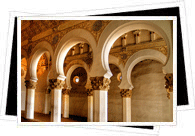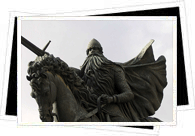 The Reconquest was a slow and discontinuous process that crept, albeit at times quite violently, through Spain. As the border between Muslim and Christian Spain moved farther and farther south, the Reconquest left a trail of thousands of frontier castles in its wake- especially through Castilla (after all, castillo means castle, from which Castilla gets its name). Having acquired enough land to comprise a kingdom, Castilla became the main driving force behind the Reconquest.
The Reconquest was a slow and discontinuous process that crept, albeit at times quite violently, through Spain. As the border between Muslim and Christian Spain moved farther and farther south, the Reconquest left a trail of thousands of frontier castles in its wake- especially through Castilla (after all, castillo means castle, from which Castilla gets its name). Having acquired enough land to comprise a kingdom, Castilla became the main driving force behind the Reconquest.
 The 1085 capture of Toledo - an important Islamic city - was a huge Reconquest stepping stone and a turning point in Spanish history. In the final years of the 11th century, Spanish history hero Rodrigo Díaz de Vivar, more commonly known as El Cid, stepped and claimed a huge part of the region of Valencia, converting him into a powerhouse of Spanish history, legend and culture.
The 1085 capture of Toledo - an important Islamic city - was a huge Reconquest stepping stone and a turning point in Spanish history. In the final years of the 11th century, Spanish history hero Rodrigo Díaz de Vivar, more commonly known as El Cid, stepped and claimed a huge part of the region of Valencia, converting him into a powerhouse of Spanish history, legend and culture.
How did Spain stay so committed to such a slow-moving, drawn-out process? As the Reconquest was very much driven by religion, Christians were united by the spirit of a religious "crusade" of sorts. In fact, the Reconquest saw the formation of several military orders of Christian knights, most famously the Knights Templar and the Order of Santiago. The second incentive was land. The captured lands had to be recolonized and integrated into the Spanish kingdom; knights and soldiers of all levels were rewarded with land as it was conquered.
With the 1212 Christian victory at Navas de Tolosa, the eventual defeat of the Moors became essentially a matter of time. The Reconquest went faster and faster and quickly took most of Al-Andalus. Castilla remained the strongest force of the Reconquest, and as such emerged as Spain's political and military nucleus; for this reason, castellano Spanish became the official language of Spain instead of gallego, vasco, or catalán. (Learn more about languages spoken in Spain)
The political marriage of the Catholic monarchs - Fernando of Aragón and Isabel of Castilla - was a major political and symbolic step leading towards the unification of Spain. The Catholic monarchs would go on to end the Reconquest when, in 1492, the final Moorish stronghold - Granada - succumbed to Reconquest. At the same time, the rather famous voyages of Christopher Columbus led to the conquest, colonization and exploitation of the new world and its resources. Spain's empire seemed unstoppable and things were looking up.